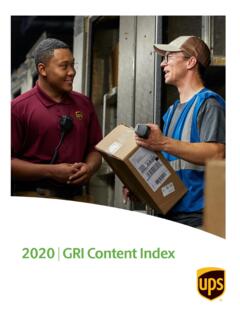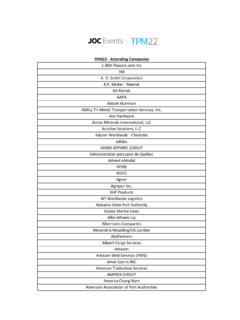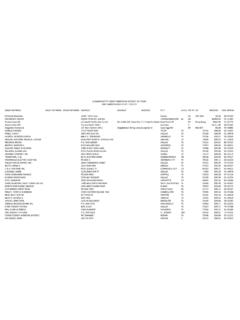Transcription of 2020 | SASB Standards Table
1 2020 | SASB Standards Table 1 2020 | SASB Standards Table 2020 | SASB Standards Table 2 The Sustainability Accounting Standards Board (SASB) is an independent non-profit organization that sets Standards to guide the disclosure of financially material sustainability information by companies to their investors. The SASB reporting Standards are sector specific, covering environmental, social and governance (ESG) reporting criteria for 77 different industries. Each SASB standard defines a minimum set of ESG-related topics that are reasonably likely to affect a company s long-term performance based on the industry it operates within. SASB s use of the term sustainability refers to corporate activities that maintain or enhance the ability of a company to create value over the long term. Sustainability accounting reflects the governance and management of a company s environmental and social impacts arising from production of goods and services, as well as its governance and management of the environmental and social capitals necessary to create long-term value.
2 Based upon our classification within SASB s Sustainable Industry Classification System, we have evaluated the Air Freight and Logistics Sustainability Accounting Standard (TR-AF). The Table below sets out the topics addressed by that standard, the related SASB Code and accounting metric and our related disclosures. For more details on our overall strategy and report process please visit +. Management Assertion Management of United Parcel Service, Inc (UPS) is responsible for the completeness, accuracy and validity of the metric disclosures in the 2020 SASB Standards Table . Management is also responsible for the collection, quantification and presentation of the sustainability metric disclosures and for the selection of the criteria, which management believes provide an objective basis for measuring and reporting on the sustainability metric disclosures. Measurement of certain metric disclosures includes estimates and assumptions that are subject to inherent measurement uncertainty resulting, for example, from accuracy and precision of conversion and other factors.
3 The selection by management of different but acceptable measurement methods, input data or assumptions may have resulted in materially different amounts or metrics being reported. Management of UPS asserts that the sustainability metric disclosures in the 2020 SASB Standards Table as of and for the year ended December 31, 2020, are presented in accordance with the Sustainability Accounting Standards Board Air Freight and Logistics Sustainability Accounting Standard. We engaged Deloitte & Touche LLP to perform a review (limited assurance) in accordance with attestation Standards established by the American Institute of Certified Public Accountants (AICPA), on management s assertion relating to the sustainability disclosures in the 2020 SASB Standards Table . + This symbol indicates that information at this link was not subject to Deloitte & Touche LLP s review and; accordingly, Deloitte & Touche LLP does not express a conclusion or any form of assurance on such information.
4 The audited financial statements included in the 2020 Annual Report - Form 10-K were audited by Deloitte & Touche LLP and its audit report, dated February 22, 2021, is included therein. This symbol indicates that information at this link was not subject to Deloitte & Touche LLP's review and; accordingly, Deloitte & Touche LLP does not express a conclusion or any form of assurance on such information. 2020 | SASB Standards Table 3 Sustainability Disclosure Topics and Accounting Metrics All Metric Disclosures are as of and for the year ended December 31, 2020 SASB Topic SASB Code Accounting Metric 2020 Disclosure Greenhouse Gas Emissions Gross global Scope 1 emissions 15,751,000 metric tonnes CO2e (All Global Operations) For more information on UPS s Greenhouse Gas (GHG) global emissions, see Appendix B within our 2020 GRI Content Index. Discussion of long term and short-term strategy or plan to manage Scope 1 emissions, emissions reduction targets and analysis of performance against those targets.
5 We help deliver what matters by providing transportation and logistics solutions that facilitate global commerce. This role requires the use of substantial amounts of energy, primarily in the form of fuel and electricity for our vehicles, aircraft, distribution facilities, warehouses and data centers. In addition to the energy used in our own network operations, we also rely on other third-party transportation providers who use fuel and energy on our behalf to transport goods via all modes of transportation, including air, ocean, road and rail. We take a comprehensive, global approach to reducing energy use and GHG emissions within our network, as well as major portions of our value chain, including customers and suppliers. We believe everyone shares responsibility to improve energy efficiency and to reduce GHG emissions in the atmosphere. UPS supports global efforts to mitigate the impact of climate change.
6 Our Corporate Climate Change Statement is also publicly available at +. Our optimized global smart logistics network, combined with our global GHG strategy, helps improve our efficiency and reduce our environmental impacts. This technology and innovation driven strategy includes: Maintaining a leadership role in decarbonizing the transportation and logistics of packages and freight; Utilizing operational improvements through technology to create overall network and delivery efficiencies beyond reducing miles/fuel ( , higher trailer utilization, decreased sortation time, increased safety, reduced errors/duplication of work, higher asset utilization/less waste, etc.) that reduce our GHG footprint; Expanding our fleet of alternative fuel and advanced technology vehicles, known as our Rolling Laboratory, in order to reduce the proportion of conventional fuels we use; Supporting the testing and development of air solutions including drone delivery and expanding the use of sustainable aviation fuel (SAF); Reducing conventional energy use and increasing the use of renewable energy in our facilities; 2020 | SASB Standards Table 4 SASB Topic SASB Code Accounting Metric 2020 Disclosure Providing customers with services that help them reduce their environmental impact; and Helping increase supplier awareness about GHG emissions and how to reduce them.
7 We also contribute actively to public discussions about environmental sustainability. This includes collaborating with leading NGOs, regulators and industry consortiums. We also participate in public policy forums, where we advocate for prudent innovation and investment in new technologies and infrastructure development. In 2020, UPS broadened its ESG vision and outlined new goals that build upon our previous sustainability goals. Recently announced, the two primary sustainability goals include a social sustainability goal positively impacting 1 billion lives by 2040 and an environmental sustainability goal achieving carbon neutrality by 2050. The road map to carbon neutrality by 2050 includes the following targets: By 2025 o 25% renewable electricity for facilities (existing goal). o 40% alternative fuel purchases as a percent of total ground fuel (existing goal). By 2035 o 30% sustainable aviation fuel.
8 O 100% renewable electricity for facilities. o 50% reduction in CO2 per package delivered for global small package (2010 baseline). Current milestones on our journey to zero Increase Electricity from Renewable Sources to 25 Percent by 2025 In 2020, total electricity being generated from renewable sources reached percent. This includes several rooftop solar arrays on UPS facilities and procurement of 88% renewable electricity within our European operations. Increase Use of Alternative Fuel to 40 Percent of Total Ground Fuel by 2025 In 2020, we continued investing in alternative fuels for our ground fleet, purchasing 142 million gallons of alternative fuels, which represented 22 percent of our total ground fuel usage. Increase Use of Sustainable Aviation Fuel to 30 percent by 2035 Today, the only decarbonization path for the aviation sector is sustainable aviation fuel (SAF).
9 Over the next several years, UPS will work with the industry to accelerate the shift to SAF. 2020 | SASB Standards Table 5 SASB Topic SASB Code Accounting Metric 2020 Disclosure Increase Electricity from Renewable Sources to 100 Percent by 2035 Renewable electricity for our facility load and electric fleet will be acquired over the next decade. Reduce the CO2e per package delivered 50% for global small package by 2035 We have seen a 14% reduction in CO2e per package from 2010 to 2020. Starting from a base year of 2020, we will reduce the CO2e per package delivered by 50% by 2035. This will be achieved by the milestones described above, along with fleet electrification. Any information relating to forward looking statements, goals, and progress against goals was not subject to Deloitte s review and, accordingly, Deloitte does not express a conclusion or any form of assurance on such information.
10 Fuel Consumption Breakdown by Mode of Transportation and Fuel Type Fuel consumed by (1) road transport, percentage (a) natural gas and (b) renewable, and (2) air transport, percentage (a) alternative and (b) sustainable (Global Operations) Total Fuel Consumption for road Transport 75,556,000 GJ Total Fuel Consumption for Air Transport 137,555,000 GJ % Ground Fuel by Type % Aircraft Fuel by Type Conventional Fuel (gas, diesel, propane) 85% Conventional Jet Fuel 100% Natural Gas 9% Alternative Fuel 0% Renewable Fuel 6% Sustainable Fuel 0% SASB Topic SASB Code Accounting Metric 2020 Disclosure Air Quality Air emissions of the following pollutants (1) NOx (excluding N2O), (2) SOx, and (3) particulate matter (PM10) NOx (excluding N2O) for road Transport 10,359 metric tonnes ( Operations) Particulate Matter (PM10 or lower) for road Transport 305 metric tons of ( Operations) SOx and International NOx and PM Omitted: UPS does not report this value as it is not tracked.






